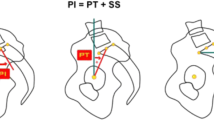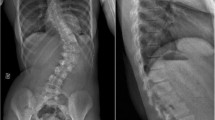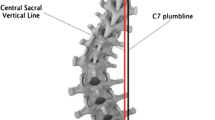Abstract
Purpose
To present in a single source the relevant information needed to assess spinopelvic balance and alignment, and to estimate the amount of correction needed in a patient during surgical treatment.
Methods
Narrative literature review
Results
Sagittal balance can be evaluated by global balance estimates (sagittal vertical axis and T1 tilt). Other important parameters are the relationship between pelvic incidence and lumbar lordosis (spinopelvic harmony), between pelvic incidence and difference of thoracic kyphosis and lumbar lordosis (spinopelvic balance), excess of pelvic tilt, knee flexion and thoracic compensatory hypokyphosis. Different methods to calculate the amount of surgical correction needed in patients with sagittal imbalance have been based on combinations of these parameters.
Conclusions
Relevant parameters of sagittal imbalance have been identified and correlated with clinical outcomes. Methods for calculation of surgical correction of imbalance have been proposed, but not validated in patients with mid-term follow-up.
Similar content being viewed by others
References
Schwab F, Patel A, Ungar B, Farcy JP, Lafage V (2010) Adult spinal deformity-postoperative standing imbalance: how much can you tolerate? An overview of key parameters in assessing alignment and planning corrective surgery. Spine 35:2224–2231
Mac-Thiong JM, Roussouly P, Berthonnaud E, Guigui P (2010) Sagittal parameters of global spinal balance: normative values from a prospective cohort of seven hundred nine Caucasian asymptomatic adults. Spine 35:E1193–E1198
Legaye J, Duval-Beaupère G, Hecquet J, Marty C (1998) Pelvic incidence: a fundamental pelvic parameter for three-dimensional regulation of spinal sagittal curves. Eur Spine J 7:99–103
Boulay C, Tardieu C, Hecquet J, Benaim C, Mouilleseaux B, Marty C, Prat-Pradal D, Legaye J, Duval-Beaupère G, Pélissier J (2006) Sagittal alignment of spine and pelvis regulated by pelvic incidence: standard values and prediction of lordosis. Eur Spine J 15:415–422
Lamartina C, Zavatsky JM, Petruzzi M, Specchia N (2009) Novel concepts in the evaluation and treatment of high-dysplastic spondylolisthesis. Eur Spine J 18:133–142
Schwab F, Lafage V, Patel A, Farcy JP (2009) Sagittal plane considerations and the pelvis in the adult patient. Spine 34:1828–1833
Mac-Thiong JM, Transfeldt EE, Mehbod AA, Perra JH, Denis F, Garvey TA, Lonstein JE, Wu C, Dorman CW, Winter RB (2009) Can C7 plumbline and gravity line predict health related quality of life in adult scoliosis? Spine 34:E519–E527
Glassman SD, Berven S, Bridwell K, Horton W, Dimar JR (2005) Correlation of radiographic parameters and clinical symptoms in adult scoliosis. Spine 30:682–688
Videbaek TS, Bünger CE, Henriksen M, Neils E, Christensen FB (2011) Sagittal spinal balance after lumbar spinal fusion: the impact of anterior column support results from a randomized clinical trial with an eight- to thirteen-year radiographic follow-up. Spine 36:183–191
Smith JS, Shaffrey CI, Glassman SD, Berven SH, Schwab FJ, Hamill CL, Horton WC, Ondra SL, Sansur CA, Bridwell KH, Spinal Deformity Study Group (2011) Risk–benefit assessment of surgery for adult scoliosis: an analysis based on patient age. Spine 36:817–824
Schwab FJ, Lafage V, Farcy JP, Bridwell KH, Glassman S, Shainline MR (2008) Predicting outcome and complications in the surgical treatment of adult scoliosis. Spine (Phila Pa 1976) 33:2243–2247
Bridwell KH, Baldus C, Berven S, Edwards C 2nd, Glassman S, Hamill C, Horton W, Lenke LG, Ondra S, Schwab F, Shaffrey C, Wootten D (2010) Changes in radiographic and clinical outcomes with primary treatment adult spinal deformity surgeries from two years to three- to five-years follow-up. Spine 35:1849–1854
Rose PS, Bridwell KH, Lenke LG, Cronen GA, Mulconrey DS, Buchowski JM, Kim YJ (2009) Role of pelvic incidence, thoracic kyphosis, and patient factors on sagittal plane correction following pedicle subtraction osteotomy. Spine 34:785–791
Roussouly P, Nnadi C (2010) Sagittal plane deformity: an overview of interpretation and management. Eur Spine J 19:1824–1836
Lee SH, Kim KT, Suk KS, Lee JH, Seo EM, Huh DS (2011) Sagittal decompensation after corrective osteotomy for lumbar degenerative kyphosis: classification and risk factors. Spine 36:E538–E544
Lewis SJ, Gray R, David K, Kopka M, Magana S (2010) Technique of reverse smith petersen osteotomy (RSPO) in a patient with fixed lumbar hyperlordosis and negative sagittal imbalance. Spine 35:E721–E725
Neal CJ, McClendon J, Halpin R, Acosta FL, Koski T, Ondra SL (2011) Predicting ideal spinopelvic balance in adult spinal deformity. J Neurosurg Spine 15:82–91
Ondra SL, Marzouk S, Koski T, Silva F, Salehi S (2006) Mathematical calculation of pedicle subtraction osteotomy size to allow precision correction of fixed sagittal deformity. Spine 31:E973–E979
Yang BP, Ondra SL (2006) A method for calculating the exact angle required during pedicle subtraction osteotomy for fixed sagittal deformity: comparison with the trigonometric method. Neurosurgery 59:ONS458–ONS463
Aurouer N, Obeid I, Gille O, Pointillart V, Vital JM (2009) Computerized preoperative planning for correction of sagittal deformity of the spine. Surg Radiol Anat 31:781–792
Vialle R, Levassor N, Rillardon L, Templier A, Skalli W, Guigui P (2005) Radiographic analysis of the sagittal alignment and balance of the spine in asymptomatic subjects. J Bone Joint Surg Am 87:260–267
Le Huec JC, Leijssen P, Duarte M, Aunoble S (2011). Thoracolumbar imbalance analysis for osteotomy planification using a new method: FBI technique. Eur Spine J 20:669–680
Conflict of interest
None.
Author information
Authors and Affiliations
Corresponding author
Rights and permissions
About this article
Cite this article
Lamartina, C., Berjano, P., Petruzzi, M. et al. Criteria to restore the sagittal balance in deformity and degenerative spondylolisthesis. Eur Spine J 21 (Suppl 1), 27–31 (2012). https://doi.org/10.1007/s00586-012-2236-9
Received:
Accepted:
Published:
Issue Date:
DOI: https://doi.org/10.1007/s00586-012-2236-9




